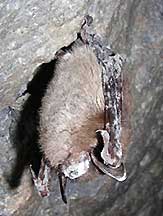 Infected bat is shown. (Photo courtesy of the US Fish & Wildlife Service)
Infected bat is shown. (Photo courtesy of the US Fish & Wildlife Service)
The summer is a time when the coolness of caves becomes a consideration in planning an outing.
"The recent report of suspected White Nose Syndrome (WNS) in two of Missouri's caves [one in a private cave in Pike County, according to the MDC] is not cause for any of Missouri's and Arkansas' cave attractions to consider closing," reports Lindsey Webster, secretary treasurer of the Missouri Caves Association.
However, as a precautionary measure the Missouri Department of Conservation and the National Park Service decided to close access to the "wild" caves within their control as a step against suspected human-assisted movement of WNS. Their decision was made in spite of the less direct cave contact afforded visitors to Missouri's caves. According to DNR officials, caves remaining open include Onondaga Cave and Cathedral Cave at Onodaga Cave State Park, Fisher Cave at Meramec State Park and Ozark Caverns at Lake of the Ozarks State Park.
White Nose Syndrome is a serious disease that infects bats. It is contained (at present writing) within seven different bat species. WNS is a slow growing fungus that grows on or attaches itself to the bats, most prominently on their faces, wings and noses.
Bats are infected during hibernation periods when their body temperatures and activity levels are the lowest rather than during the times of the year when they are most active. Spread of WNS has been very rapid. Irritation caused by WNS causes the bats to wake and use up energy reserves long before spring arrives. Death occurs from starvation or freezing conditions.
First detected in the northeastern and New England states, WNS spread westward into the Ohio and Tennessee valleys and finally into Missouri. While much research is taking place, not a lot about the spread of it is certain. WNS is referred to as a syndrome because the suspect fungus may be just one of the factors contributing to the high mortality rate among bats at infected sites. These sites include caves, mines, and other places bats hibernate.
WNS does not infect humans or any animals other than bats. Laboratory studies show that Geomyces destructans can be spread from bat-to-bat and from one infected site to another by bat movement. The mortality rate is high and there is no known cure but researchers are studying treatment options.
While commercial cave owners, controlling about 74% of the caves with a potential for 5,000 bat colonies, question whether there is scientific proof that people can unintentionally transport the spores, it has been reported that some biologists believe that the fungus may be passed from bat to bat by the wind as well as by infected clothing worn by cave explorers.
Bats provide one of the most efficient insect control methods known to man, assist with the pollination of fruit crops and contribute to the ecosystem of caves in several ways. The Missouri Caves Association and its member caves care greatly about the future of the bats and the impact that WNS is having on them. Along with the National Caves Association they have contributed nearly one half of their annual budgets to WNS research this year.
State officials will be meeting shortly to continue to pursue a Missouri-wide WNS action plan to address the threat of WNS.
The Missouri Caves Association is located at 526 Bridal Cave Rd., Camdenton. Phone contact: (573) 346-2676. For more information about bats and WNS send an e-mail to Dr. William R. Elliott, Missouri Dept. of Conservation, here.






Comments